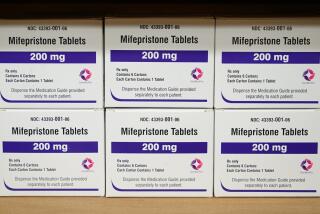Jess Hutchison / Los Angeles Times
The TikTok video begins with a young woman sitting in the passenger seat of her car, looking around unassumingly. Tense music builds to a crescendo, like in a horror movie. The video’s caption reads, “Doing Kegels all the time because I thought it was supposed to be good for me.”
The woman looks over to the driver’s seat, and — smash cut — she’s there too, or rather, her evil twin is, with a sinister look, as the music peaks. The doppelganger has her own caption: “Pelvic floor dysfunction.”
The TikTok’s creator, Alicia Jeffrey-Thomas, is a pelvic health physical therapist in Medfield, Mass., who goes by the moniker the Pelvic Dance Floor. She has posted various videos on this topic, noting that “just do Kegels” is far from a panacea (akin to telling everyone with a shoulder injury to perform bicep curls).
Jeffrey-Thomas has amassed nearly 1 million followers on TikTok with her humorous and informative pelvic health clips, tackling everything from proper bladder release to birth prep exercises. (Pelvic health includes the pelvic organs such as the bladder, bowel, uterus, vagina and pelvic floor, which consists of muscles and ligaments.) She mostly attracts women in their 20s and 30s, some of whom say they were “pushed off” or that their pelvic pain was minimized by healthcare providers. “So they’re looking for answers on the internet,” says Jeffrey-Thomas.
Jeffrey-Thomas is one of many professionals filling this educational gap. The rise of TikTok pelvic health influencers joins a wider ecosystem of startups, grassroots awareness efforts and consumer brands answering increased demand. But despite growing awareness, proper diagnosis and evidence-based treatments are still out of reach for most Americans, and as with any wellness boom, the bunk fills in the cracks.
“This sector is exploding right now,” says Jeffrey-Thomas. “If you compare where we are now to even five years ago, it’s a completely different landscape.”
Underserved, embarrassed and speaking out
Oftentimes, women first learn about the pelvic floor when they have an injury, and then they don’t know where to seek help.
About a quarter of U.S. women suffer from pelvic dysfunction, such as urinary incontinence, fecal incontinence and pelvic organ prolapse, according to a study published in the American Journal of Obstetrics and Gynecology. Some examples include urinary leakage while exercising, chronic pelvic discomfort and pain during sex. Although less common, men are also afflicted.
Many factors play into the prevalence of disorders, including pregnancy, childbirth, genetics and the aging process. Obesity is also believed to impact disorders since higher weight puts pressure on the pelvic floor. Pelvic treatment spans physical therapy, surgical intervention and devices.
Yet many are embarrassed to seek care, fear they’ll be dismissed at the doctor’s office, or they assume symptoms are simply part of the aging process, according to a survey conducted by the National Association for Continence.
CBD butt balm, charcoal cheese and other ridiculous wellness products are losing their luster as Gen Z shoppers exhibit a more critical eye.
That’s changing as women try to spread the word with podcasts, YouTube videos, blogs and social media. Google searches for “pelvic care” increased by 62% since 2018, and the hashtag #pelvicfloor boasts 600,000 Instagram posts.
In 2020, Tiffany Broadway launched the Pelvic Awareness Project, a nonprofit event series and educational platform that now averages 23,000 unique visitors a month. “I realized nobody was really talking about it,” said Broadway. “Doctors weren’t [even] talking about it.” (Broadway previously worked at Caldera Medical, which manufactures medical devices for pelvic floor disorders.)
“There’s an awareness that this isn’t something we need to suffer silently from,” says urogynecologist Dr. Cheryl B. Iglesia, a professor at Georgetown University School of Medicine and the president of the Society of Gynecologic Surgeons.
At the same time, experts acknowledge that some influencers hawk products and services, while websites publish debatable health content. It’s a double-edged sword; it’s great we’re having the conversation, but not everyone is qualified to dish out advice. “While [content] can be funny and cute, it definitely isn’t always accurate,” says Stephanie A. Prendergast, co-founder of Pelvic Health and Rehabilitation Center, which has 10 centers, including in L.A.
And then there’s another, bigger issue: Is there enough accessible care?
False promises in pink wrapping
Sheree DiBiase, a physical therapist and owner of Lake City Physical Therapy in Coeur d’Alene, Idaho, can’t keep up with pelvic health patient demand. She started with two clinics seven years ago and now has seven across Idaho and Washington state. On average, each clinic has a 20- to 40-person waiting list. “The only thing that prevents us from growing more is that we don’t even have enough [physical therapists] to hire,” said DiBiase.
A short supply stems from the fact that most PT schools don’t train in pelvic health; therapists usually learn the subspecialty in post-graduate work or during clinical rotations. While there is no formal accounting of all pelvic health physical therapists, clinics and associations attest to increasing demand.
The Academy of Pelvic Health Physical Therapy, a nonprofit professional association that counts more than 3,700 members, reports a 15% increase in membership growth and a 254% increase in course offerings and demand for continuing education since 2018. Still, that’s likely not enough. DiBiase and her team train PTs in such specialized work, which costs $8,000 to $10,000 per therapist. “And we don’t really get reimbursed for how much money, time and effort it takes us to bring our people up to [the pelvic health work] level,” DiBiase said.
Scarce care propelled the launch of Origin, a physical and virtual clinic. The two-year-old company has already become the largest in-network provider of pelvic floor physical therapy in the U.S., with seven clinics across Texas and California (including San Francisco, West Hollywood and Brentwood), and now expanding virtual care across 39 states. Most patients find Origin through word-of-mouth or provider referrals — OB-GYNs, doulas and even fitness instructors — but also via Instagram. Allison Grant, head of growth at Origin, compares pelvic health awareness to that of mental health. “It’s become much more mainstream,” she says.
While most of Origin’s patients are in-person, roughly half complement their care virtually. For patients who need ongoing care — especially busy moms — finding the time to visit a clinic can prove prohibitive.
Some experts are skeptical of virtual care, especially as it relates to ensuring proper technique for prescribed exercises, which can include contraction and relaxation movements, stretching, specific exercises to target muscles and hands-on vaginal manipulation or massage. Remote care can’t confirm coordination for muscles inside the body, explains Julia Barten, a pelvic health physical therapist at the Stanford Pelvic Health Center. Virtual visits are far more accessible, she adds, but telehealth isn’t necessarily equivalent to an in-person visit.
As a Black woman, I’m used to doctors not taking my pain seriously. But many physicians fail to see how they too can internalize racism and misogyny.
Origin notes some severe cases are best served in person. Dr. Pamela Moalli, director of urogynecology and reconstructive pelvic surgery at the University of Pittsburgh School of Medicine Magee-Womens Hospital, however, still thinks virtual care can help those barred from attending physically. “It’s one solution.”
Origin now works with Anthem, Blue Cross, UnitedHealthcare, Aetna and Cigna. By Origin’s estimate, 80% of pelvic floor PT providers are out of network, which means it’s unaffordable for many in need.
“Insurance companies are beginning to see the value in the care and the cost savings that it provides down the line,” says Liz Miracle, Origin’s head of clinical quality and education. Insurance coverage was one factor that drew investors to Origin. Maria Velissaris, a founding partner of SteelSky Ventures, which invested in Origin, says there’s a huge opportunity in the pelvic health sector, noting, “We were really interested in this because it touches a lot of different phases of a woman’s life.”
Silicon Valley funded a slew of new femtech clinics and digital platforms, a sector that now includes pelvic health companies such as Bloom and Pelvic Gym. That’s in addition to pelvic floor strengthening devices, vibrators, balls and exercise apps. The global pelvic floor diagnostics market is valued at $166 million and expected to reach $290 million by 2032, according to market research firm Fact.MR. Experts also point to promising medical therapeutic devices such as the Leva Pelvic Health System, which is FDA-cleared for female urinary and fecal incontinence.
However, issues can arise with people buying these products off Instagram ads. Some can be helpful, but certain devices require instruction on how to effectively implement them as part of a treatment plan, stresses Prendergast (who also consults for pelvic floor device company Materna). If, for example, an individual purchases a dilator due to painful sex, “How long should they be using it? What should it feel like? What amount of pain is OK with that? These are the questions that people are struggling with as they try to manage their own symptoms.”
Then there’s the issue of false promises wrapped up in pretty pink packaging. Like the menopause market, critics worry that some products and expensive treatments lack efficacy or exaggerate health claims. (See: Goop’s infamous jade eggs.) Los Angeles clinics for years have offered so-called vaginal “rejuvenation” procedures to help with urinary issues and painful intercourse — despite warnings by the FDA and medical industry groups of potential harms like vaginal burn. Price is another sticking point since many products — even legitimate ones — are paid for out of pocket. Some can cost $200. (Meanwhile, most insurance policies cover vacuum constriction devices for erectile dysfunction, i.e., penis pumps.)
“There is a serious disparity between the way women’s health is approached and the way men’s health is approached.”
— Stephanie A. Prendergast, co-founder of Pelvic Health and Rehabilitation Center
“There is a serious disparity between the way women’s health is approached and the way men’s health is approached,” says Prendergast.
Dr. Alexandra Dubinskaya, a physician and pelvic medicine and reconstructive surgery fellow at Cedars-Sinai Medical Center, says some devices can assist with pelvic function exercises and improve symptoms of stress urinary incontinence, but if they don’t work, surgical intervention can often provide the best outcome.
‘Very limited resources’
This past summer, legislation for postpartum pelvic floor physical therapy was introduced in the House of Representatives. That doesn’t necessarily mean an overhaul anytime soon, but it does signal that lawmakers are, at the very least, acknowledging healthcare gaps. Overall, pelvic floor physical therapy “continues to be underutilized by medical providers,” reports Heather Jeffcoat, president of the Academy of Pelvic Health Physical Therapy.
OB-GYN visits often don’t permit enough time to screen for or discuss all gynecological issues. U.S. medicine is also highly specialized and siloed, with doctors generally focusing on specific organs and likely not well trained to recognize and treat pelvic floor disorders.
A 2021 meta-analysis (a study of existing studies) found that nearly one-third of women who deliver vaginally will develop urinary incontinence, and other studies suggest roughly 20% experience an injury to their pelvic floor. “Everyone is so supportive of women having a vaginal delivery, but there are very limited resources for where to find help should they develop a pelvic floor dysfunction,” says Dubinskaya.
It’s estimated that 40% of U.S. women do not attend a postpartum visit, according to the American College of Obstetricians and Gynecologists. In some countries, women who have given birth are screened early for disorders. France, for example, offers postnatal pelvic floor therapy to new mothers.
Apart from support for increased screening and treatment, there are also calls for more research. While researchers attest to a number of options for advanced and mild disorders, Moalli would like to see more research regarding preventative measures and to develop targeted novel therapies. For example, therapies that maximize stretching of the pelvic floor muscles at the time of vaginal birth and procedures to repair a pelvic floor injury when it occurs “will substantially reduce the incidence of pelvic floor disorders,” many of which aren’t detected until decades later, explains Moalli.
Doctors from Beverly Hills to Newport Beach offer “vaginal rejuvenation” to improve sex after menopause. But the treatment is risky and expensive.
Women’s health conditions have been historically under-researched, particularly those that fall within the realm of obstetrics and gynecology. According to the Society for Women’s Health Research, current levels of pelvic health research funding are “insufficient based on the millions of women living with these conditions.”
One root issue is the lack of physician-scientists in this field, says Moalli. This is in part due to a lack of funding and robust training programs that attract trainees into reproductive health fields. It’s easier to attract students to better-funded areas, such as cancer research. Moalli notes there are fewer than 10 U.S. labs dedicated to studying the underlying causes of pelvic floor disorders.
Still, there are certainly more research opportunities than decades prior. And overall, pelvic health professionals attest to optimism and enthusiasm.
TikTok creator Jeffrey-Thomas receives comments every day from people thankful they’ve found her content after being told they had to live with going to the bathroom every hour or peeing their pants with each sneeze. “They feel more empowered to seek out care for themselves,” she says, adding, it can only get better from here. “The energy that’s been created by all of the different people working in this space is really helping propel us forward.”
More to Read
Sign up for The Wild
We’ll help you find the best places to hike, bike and run, as well as the perfect silent spots for meditation and yoga.
You may occasionally receive promotional content from the Los Angeles Times.














